Prev Page--Clastics and Coal || Next Page--Organic Mudstones
Basement Rocks
Igneous and metamorphic basement rocks contain some significant oil and gas reservoirs in various parts of the world, particularly in Asian countries. So, for example, most of Vietnam's oil production comes from the fractured granite basement. However, other important basement reservoirs are found in North Africa, as well as one of the North Sea fields (Lancaster).
- Exploration targets are usually basement uplifts adjacent to younger oil source rocks.
- Lengthy oil columns are needed for commercial production because porosity is restricted to fractures (typically 2% by volume) and vugs developed by weathering.
- What they lack in volume, fractures make up with high permeability.
- Tectonically created fractures are the key to production, so that granites are better reservoir prospects than basalts and quartzites are favored over more ductile schists.
- In oil exploration, igneous and metamorphic rocks are often collectively grouped as "crystalline rocks".
Consequently, logs are run routinely in Precambrian basement wells, but their interpretation is different from conventional sedimentary rocks, not only because the mineralogy is often more exotic but that interparticle porosity is minimal to non-existent.
However, some basic rules of log interpretation are outlined on the next page and match expectations of standard properties of igneous and metamorphic rocks.
Basic Log Interpretation Rules for Igneous and Metamorphic Rocks
The Gamma-Ray Log
Gamma-ray values
- are very high in acid igneous rocks (granites and rhyolites)
- are very low in basic igneous rocks (gabbros and basalts).
- are typically low in metamorphic rocks except those with significant potassium feldspar content.
The photoelectric factor (PeF) log
In evaluating crystalline rocks, recall that the PeF value is a direct function of the aggregate atomic number of elements in the rock. Consequently:
- the silica and aluminosilicate minerals of acid igneous rocks results in moderate PeF values
- magnetite and ferromagnesian minerals in basic igneous rocks causes high PeF values
- typically low PeF values are logged in metamorphic rocks other than those with iron-bearing or other metallic minerals
The neutron porosity log
Open pores typically have very low volumes in igneous and metamorphic rocks. Consequently, the neutron response should be considered in terms of hydrogen content related to hydroxyls in mineral composition and bound water created by weathering processes. In summary:
- low neutron porosity values in acid igneous rocks
- fairly low neutron porosity values in basic igneous rocks, except for subaerially weathered basaltic lavas
- low values in silica-rich metamorphics but increased values in micaceous rocks and very high values in chlorite schists
The density log
The standard scaling of the density log in porosity units (either limestone or sandstone equivalent units) has only indirect meaning for igneous and metamorphic rocks, other than its use on an overlay convention with neutron porosity logs. However, the density log will also be recorded as bulk density in gm/cc on any logging run. The bulk density is a valuable diagnostic of igneous and metamorphic rocktype.
- acid igneous rocks have a lower bulk density
- basic igneous rocks have a much higher bulk density
- siliceous metamorphic rocks generally have a lower bulk density than micaceous metamorphic rocks.
The great range in igneous and metamorphic rock composition means that individual formations should be considered on a case-by-case basis.
The rest of the lesson shows some examples of logs of basement rocks that occur in Kansas. First, a Precambrian granite.
Granite
The log below is from a well drilled in Russell County, where the Pennsylvanian LKC limestone-shale succession directly overlays a Granite Wash development from erosion of the Precambrian basement granite at the bottom of the well.
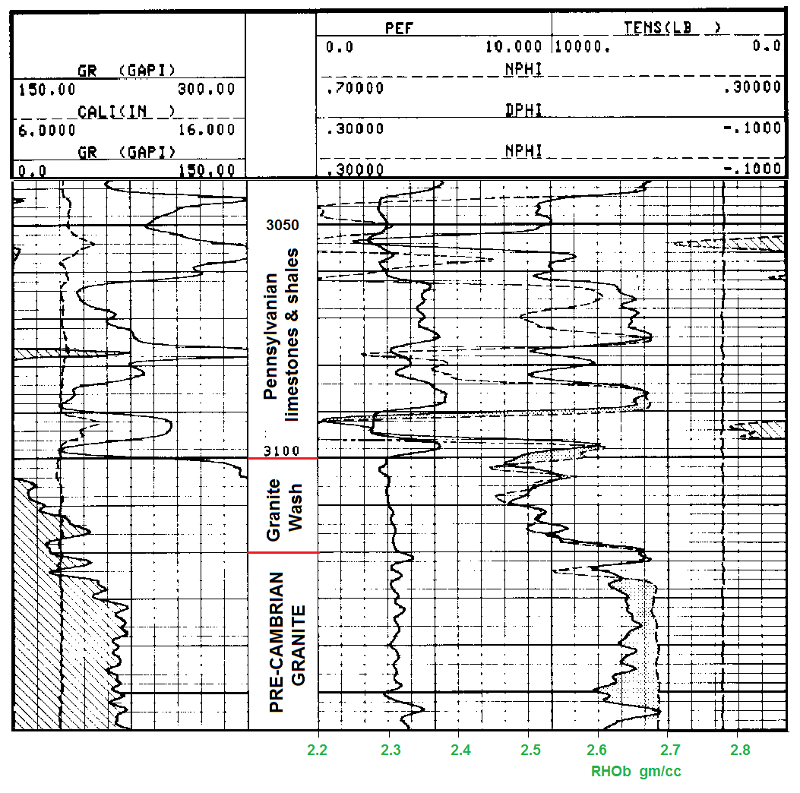
The Precambrian granite has:
- a high gamma-ray response of about 220 API units
- a moderate photoelectric factor (PeF) of about 3.2 b/e
- a neutron porosity reading of about 1 limestone-equivalent unit
- a bulk density of about 2.6 gm/cc
The overlying "Granite wash" is a general term for arkosic detrital material that immediately overlies Precambrian granitic rocks. Its age is assigned according to the overlying unit, so that when this is Upper Cambrian Lamotte Sandstone, then it is considered to be Precambrian. However, this well was drilled on an upwarped ridge, where the Granite wash is immediately succeeded by Pennsylvanian limestones and so is considered to be Pennsylvanian in age.
The contact between the Granite Wash and the granite can be seen in the marked increase in porosity to about 14%.
This well was completed with oil production from the Granite wash that was commingled with production from the Pennsylvanian limestones.
Some neighboring wells produce oil directly from the fractured Precambian granite, as documented by Walters (1953) including a well approximately a mile to the east that had an initial production of 429 barrels of oil when it was drilled in 1938.
Now let us look at the logs of metamorphic rocks.
Metamorphic Rocks in Kansas
Precambrian sediments and metasediments are found in a broad band across north-east Kansas. Rock types include schist, gneiss, quartzite, arkosic quartzite, arkose, and undifferentiated metamorphic clastics (Merriam, 1963).
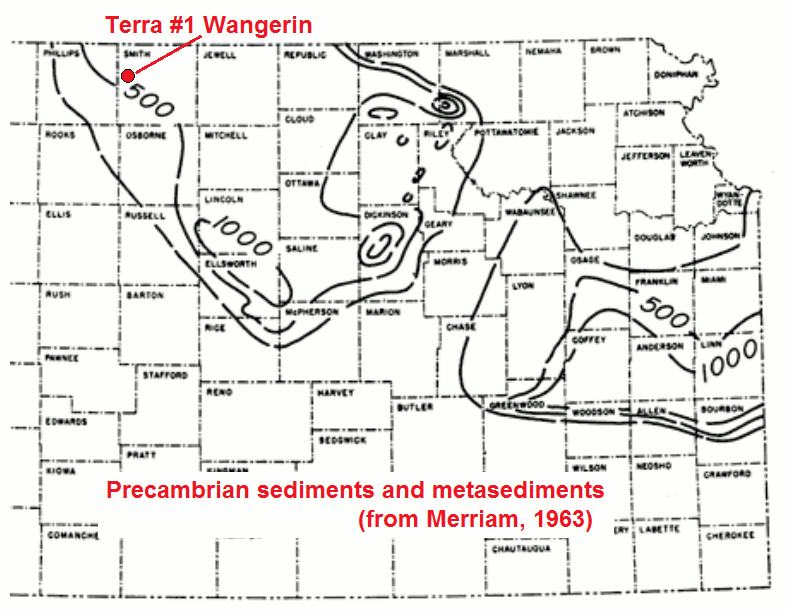
The first log example is of a chlorite schist.
Chlorite Schist
Terra Resources #1 Wangerin #1 is located in Smith County, Kansas and drilled through the Cambro-Ordovician Arbuckle Limestone into over a hundred feet of Precambrian metamorphics.
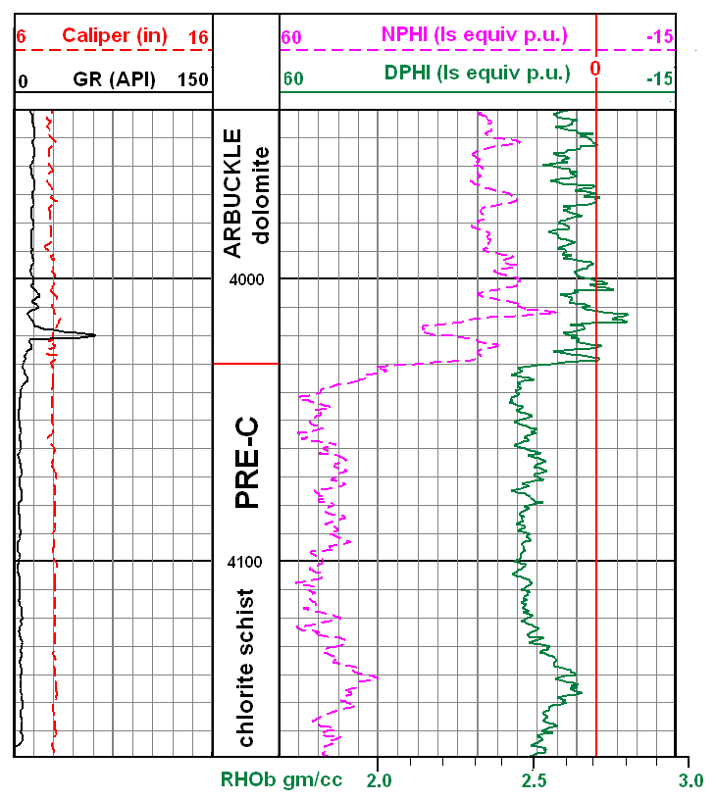
It is probable that the original plan had been to finish drilling when the hole encountered granitic basement. However this did not occur, so sidewall cores were taken and the Precambrian section was determined to be chlorite schist.
In looking at the logs, first notice the expanded scale with a range between -15 and 60 porosity units in order to accommodate the neutron porosity curve in the chlorite schist section
- The Chlorite schist shows a neutron porosity of about 50 porosity units and a bulk density of about 2.5 gm/cc
- Schlumberger tabulated values for pure chlorite are a neutron porosity of 52% and a density of 2.76 gm/cc.
- The high neutron reading is caused by the significant hydration of this mineral which has the formula (Fe, Mg, Al)6(Si, Al)4O10(OH)8. The range of potential compositions is matched by a range of densities.
- The low radioactivity of the formation would certainly be consistent with the origin of this schist as a product of regional metamorphism of basic igneous rocks.
Now let us look at a well from a gneiss terrane.
Precambrian Gneiss Terrane
The basement in northern Kansas is generally considered to be a granitic terrane with patches of metasediments, while the Nebraskan basement appears to be composed of metamorphic gneiss and schist of island-arc origin penetrated by younger granite plutons.
A well was drilled into the Precambrian of Brown County close to the Nebraska border and penetrated metamorphic rocks. Details on this well were reported by Newell et al. (2007).
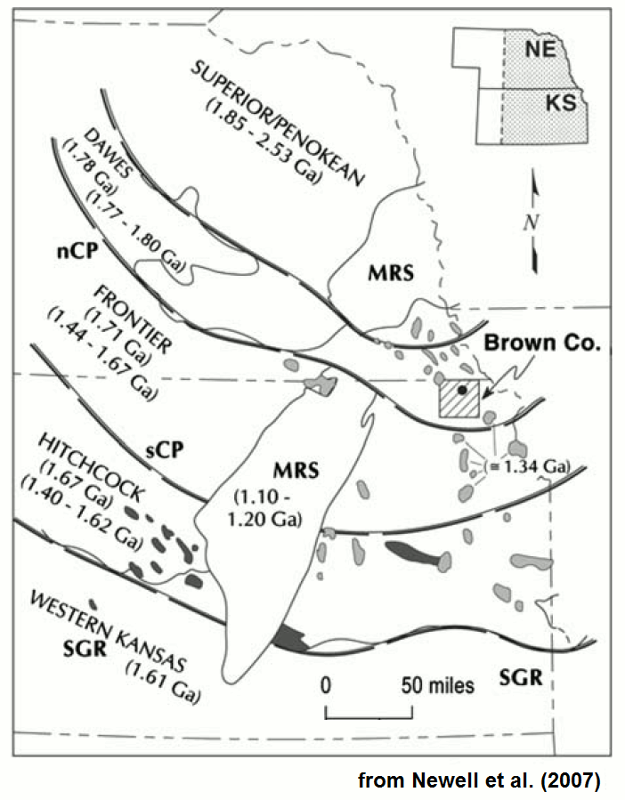
Part of the logged section is shown next.
Logs of Biotite Schist and Gneiss
The upper section of the Precambrian in this well was identified from cuttings as biotite schist, with a sharp contact and lower section of layered gneisses of differing composition ranging between aplitic gneiss, gneiss, and amphibolitic gneiss.
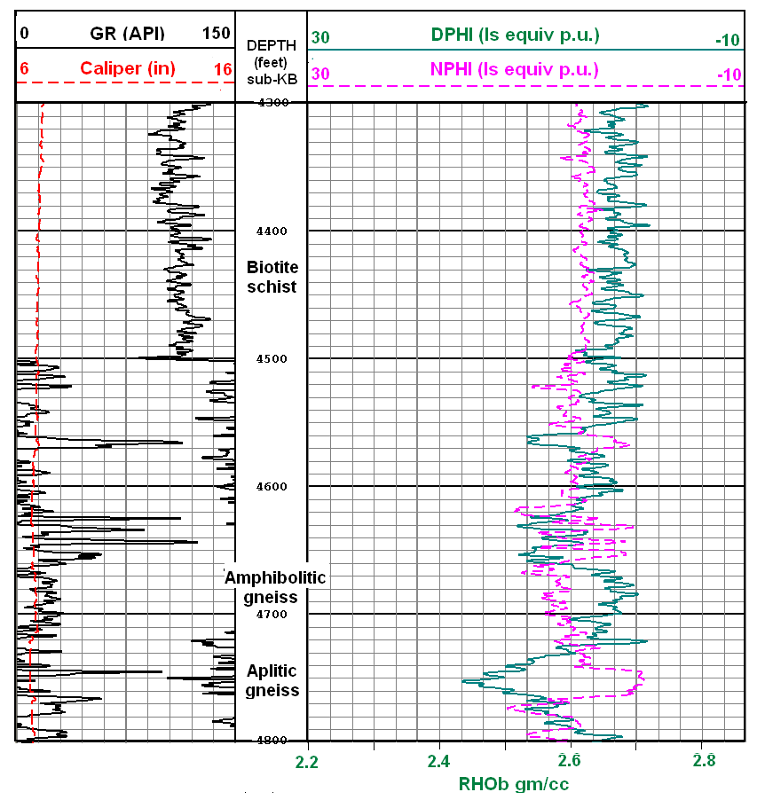
The gneiss facies can be identified from the logs by:
Aplitic gneiss:
- higher gamma-ray
- lower neutron porosity
- lower bulk density
Amphibolitic gneiss:
- lower gamma ray
- higher neutron porosity
- higher bulk density
Next, we review logs recorded from the deepest well in Kansas.
The Deepest Well in Kansas
The Midcontinent Rift System (MRS) is recognizable an elongate magnetic and gravity anomaly that extends from south-central Kansas into the Lake Superior region. The rocks that cause the geophysical anomalies are predominantly mafic volcanics interbedded with thousands of feet of clastic sediments deposited in response to subsidence of the rift.
Texaco Poersch #1 was drilled in 1984 to a depth of 11300 feet, penetrating the igneous rocks and sediments within the Kansas leg of the MRS. As the deepest hole in Kansas, it was over half a mile deeper than any other borehole.
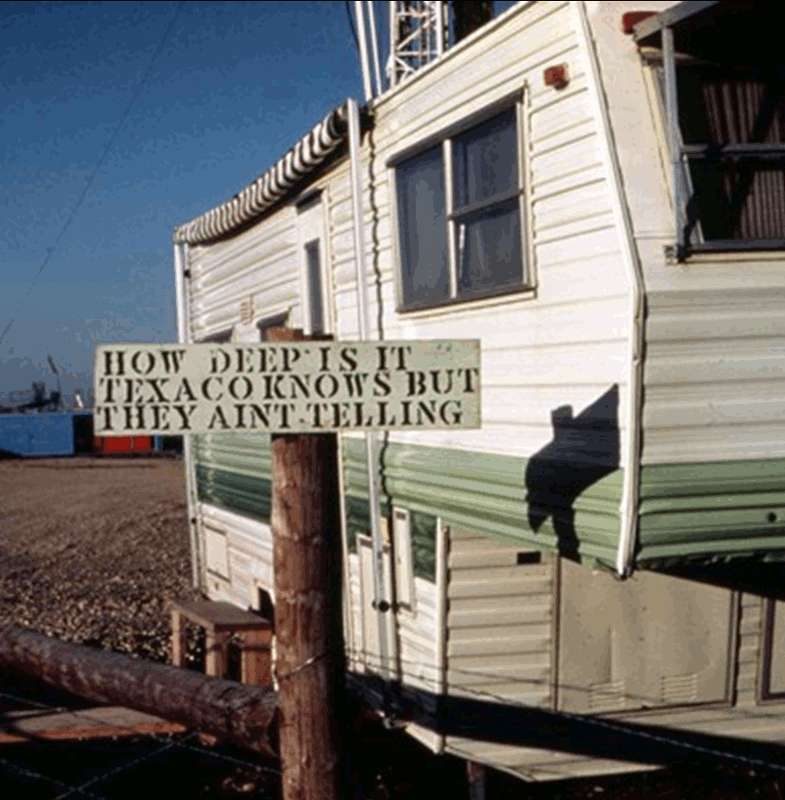
The rift rocks penetrated consisted of mafic volcanics and subsidiary mafic and acidic intrusives down to a depth of 7429 feet, which are probably about 900 million years old. Below this, the section is dominated by arkoses and subarkosic sediments, together with some minor mafic flows.
More details of this unique and historic hole are reported by Berendsen and others (1988).
Precambrian Rift Basaltic Lavas and Arkoses
The logs and cuttings are shown for an 800 feet section of the Precambrian. Note that in this instance, the neutron-density porosity scaling convention is calibrated with respect to an apparent sandstone scale.
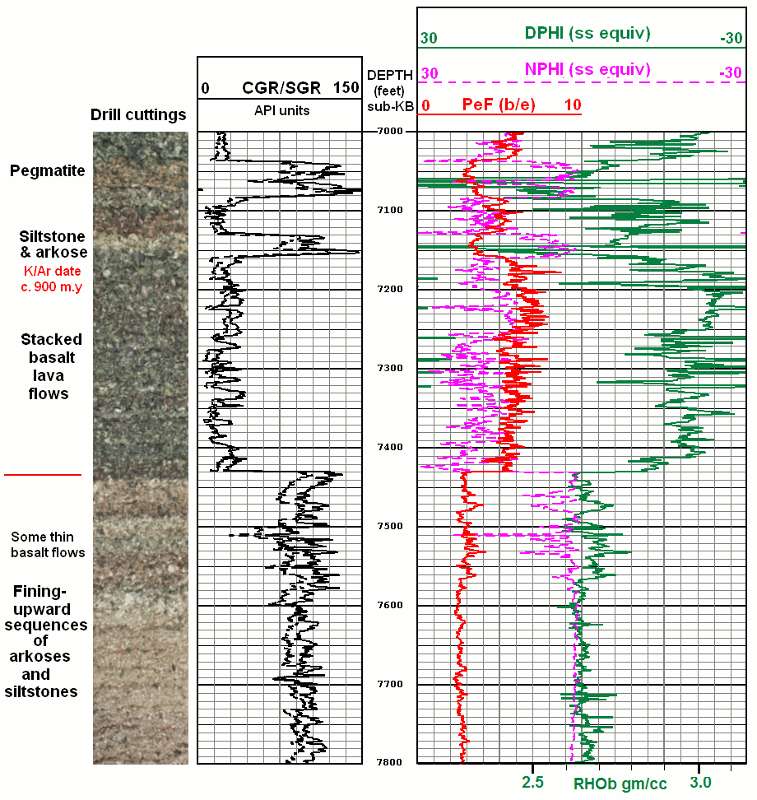
The basaltic lava flows and gabbro of the upper sequence are characterized by
- low gamma ray values,
- an equivalent neutron porosity of about 20 units,
- an apparent negative density porosity, which is equivalent to about 3 gm/cc.
- and a moderately high photoelectric factor (PeF), caused by iron in magnetite and ferromagnesian minerals.
Some of the denser zones are matched with magnetite-rich basalts and sulfide-rich gabbro. The moderate neutron response is fairly typical of weathered basalts and appears to be caused by hydrothermal alteration mineral products.
The pegmatite zones are marked by much higher radioactivity,as a result of igneous fractionation, where potassium , thorium and uranium tend to be enriched in minerals of the later, more acid stages.
The sedimentary rocks of the lower sequence are mostly tight arkoses and subarkoses, with an average porosity of 1.8%.
The high gamma radiation of these sediments is caused by the potassium content of the feldspars, together with significant thorium and uranium retained from their granite source rocks.
Prev Page--Clastics and Coal || Next Page--Organic Mudstones
Kansas Geological Survey
Placed on web March 24, 2017.
Comments to webadmin@kgs.ku.edu
The URL for this page is http://www.kgs.ku.edu/Publications/Bulletins/LA/09_igneous.html